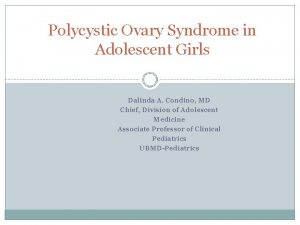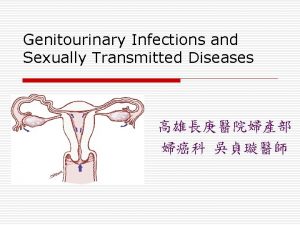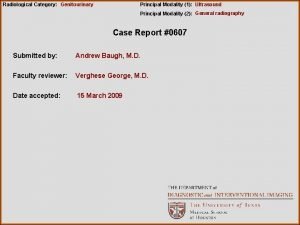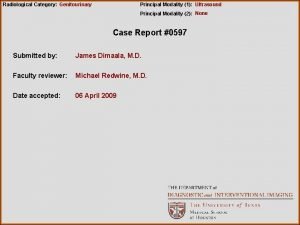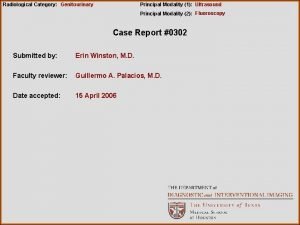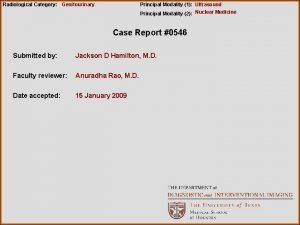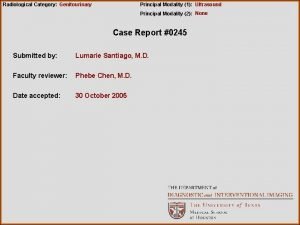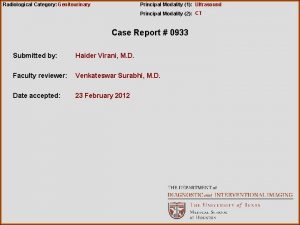Radiological Category Genitourinary Principal Modality 1 Ultrasound Principal













- Slides: 13

Radiological Category: Genitourinary Principal Modality (1): Ultrasound Principal Modality (2): CT Case Report #0391 Submitted by: Bhumi Rawal, M. D. Faculty reviewer: Chitra Chandrasekhar, M. D. Date accepted: 09 March 2007

Case History 24 year old female presents with lower abdominal pain. Patient is afebrile.

Radiological Presentations

Radiological Presentations +-

Radiological Presentations Transvaginal US of pelvis

Radiological Presentations Transvaginal images of right adnexa

Test Your Diagnosis Which one of the following is your choice for the appropriate diagnosis? After your selection, go to next page. • Ruptured ectopic pregnancy • Ruptured corpus luteum cyst • Tuboovarian abscess • Splenic injury • Ovarian torsion

Findings and Differentials Findings: On CT: High density free fluid around the liver and spleen and in the pelvis, representing hemoperitoneum. Enlarged right adnexa with a thick walled and peripherally enhancing cystic lesion. Appendix not visualized. On Ultrasound: Echogenic pelvic fluid. 2. 5 cm round lesion with hypoechoic center and surrounding thick, echogenic, and vascular ring located in the right ovary. This lesion demonstrates increased through transmission. Heterogeneous complex mass encasing right ovary, likely representing hematoma. Unremarkable left ovary and uterus. Differentials: • Ruptured hemorrhagic (corpus luteum) cyst • Ruptured ectopic pregnancy • Tuboovarian abscess • Ruptured ovarian endometrioma

Discussion In cases of acute pelvic pain in a female, the differential diagnosis includes ovarian cyst rupture and/or hemorrhage, acute appendicitis, ectopic pregnancy, ovarian torsion, endometriosis, pelvic inflammatory disease (PID), bowel inflammatory process, and neoplasm. Diagnosis of tuboovarian abscess/PID is unlikely in this patient given the absence of fever or significant leukocytosis. Also, tuboovarian abscesses are usually bilateral. The main differentiation between a ruptured hemorrhagic cyst and ruptured ectopic pregnancy is a negative serum pregnancy test. This patient’s serum B-HCG test was negative. Also, ruptured ectopics occur very rarely in the ovary whereas if the “adnexal ring” can be reliably found to be outside the ovary, ectopic tubal pregnancy is the likely diagnosis. Flow was demonstrated in the ovary, excluding ovarian torsion. This patient’s symptoms resolved spontaneously. Almost all hemorrhagic ovarian cysts resolve within 1 -2 menstrual cycles, compared to other types of ovarian masses.

Discussion Ovarian cysts are the most common cause of adnexal masses. Hemorrhage into cysts is a frequent complication; sometimes it is so severe, cyst rupture can be occur and be life-threatening. Hemorrhagic ovarian cysts (HOCs) are a frequent cause of acute lower abdominal or pelvic pain in women of reproductive age. HOCs can be functioning or nonfunctioning cysts. Functional hemorrhagic cysts are more common and consist of follicular or corpus luteal types. Follicular cysts occur in the first half of the menstrual cycle while corpus luteal cysts occur in the latter half. Given their hypervascular walls, corpus luteal cysts are the most common etiology of hemorrhagic cysts and may cause significant bleeding.

Discussion Generally, hemorrhagic ovarian cysts are diagnosed by US. Sonography findings: HOCs have a wide variety of sonographic appearances and can be of any size (up to 15 cm) or echogenicity. • Majority of HOCs have increased sound through-transmission. • Most common appearance is a heterogeneous mass, which 50% of the time is predominantly anechoic with hypoechoic material. • HOCs can be completely homogenous, either hypo- or hyperechoic. • Some contain a round hyperechoic mass, representing a blood clot. • Associated findings can include fine strands or septations in the mass and fluid in the cul-de-sac. • Occasionally HOCs demonstrate an adnexal ring sign—round hypoechoic center surrounded by a thick echogenic ring. However, this sign is considered one of most predictive US findings of ectopic pregnancy. Differentiation between an ectopic and HOC is largely dependent on serum HCG level. • HOCs can mimic the appearance of endometriomas, dermoid cysts, ovarian tumors, and tuboovarian abscesses. CT findings: • Ovarian cyst with an thick, enhancing rim and highly attenuated contents. • Discontinuous ovarian wall in some cases (suggesting cystic rupture). • High density peritoneal fluid.

References: • • • Adnexa. In: Middleton WD, Kurtz AB, Hertzberg BS. Ultrasound: The Requisites. St. Louis, MO: Mosby, 2004: 558 -586 Baltarowich OH, Kurtz AB, Pasto ME, Rifkin MD, Needleman L, Goldberg BB. The Spectrum of Sonographic Findings in Hemorrhagic Ovarian Cysts. AJR 1987; 148: 901 -905 Choi HJ, Kim SH, et al. Ruptured Corpus Luteal Cyst: CT Findings. Korean J Radiol 2003; 4: 42 -45 Hertzberg BS, Kliewer MA, Bowie JD. Adnexal Ring Sign and Hemoperitoneum Caused by Hemorrhagic Ovarian Cyst: Pitfall in the Sonographic Diagnosis of Ectopic Pregnancy. AJR 1999; 173: 1301 -1302 Nemoto Y, Ishihara K, Sekiya T, Konishi H, Araki T. Ultrasonographic and Clinical Appearance of Hemorrhagic Ovarian Cyst Diagnosed by Transvaginal Scan. J Nippon Med Sch 2003; 70: 243 -249

Diagnosis Probable ruptured corpus luteum cyst with hemoperitoneum
 Pcos ultrasound vs normal ultrasound
Pcos ultrasound vs normal ultrasound Pa erate
Pa erate Tennessee division of radiological health
Tennessee division of radiological health Center for devices and radiological health
Center for devices and radiological health National radiological emergency preparedness conference
National radiological emergency preparedness conference Radiological dispersal device
Radiological dispersal device Male genitourinary anatomy
Male genitourinary anatomy Chapter 29 the child with a genitourinary condition
Chapter 29 the child with a genitourinary condition Nursing diagnosis for undescended testis
Nursing diagnosis for undescended testis Chapter 29 the child with a genitourinary condition
Chapter 29 the child with a genitourinary condition Genitourinary & stds
Genitourinary & stds Modality
Modality High modality definition
High modality definition Epistemic modality
Epistemic modality
